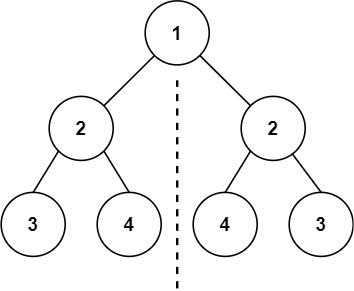0101 - Symmetric Tree (Easy)
Problem Link
https://leetcode.com/problems/symmetric-tree/
Problem Statement
Given the root of a binary tree, check whether it is a mirror of itself (i.e., symmetric around its center).
Example 1:

Input: root = [1,2,2,3,4,4,3]
Output: true
Example 2:

Input: root = [1,2,2,null,3,null,3]
Output: false
Constraints:
- The number of nodes in the tree is in the range
[1, 1000]. -100 <= Node.val <= 100
Follow up: Could you solve it both recursively and iteratively?
Approach 1: Recursive
A tree is symmetric if the following conditions are satisfied
- two nodes should have the value
- the left sub-tree is a reflection of the right sub-tree of the other tree
- C++
- Java
- Python
- JavaScript
class Solution {
public:
bool f(TreeNode* r1, TreeNode* r2){
// if two nodes r null, they are same
if(!r1 && !r2) return true;
// if one of them r null, they are not same
if(!r1 || !r2) return false;
// if their values are same, and the sub-nodes are same
return (r1->val == r2->val) && f(r1->left, r2->right) && f(r1->right, r2->left);
}
bool isSymmetric(TreeNode* root) {
return f(root, root);
}
};
/**
* Definition for a binary tree node.
* public class TreeNode {
* int val;
* TreeNode left;
* TreeNode right;
* TreeNode() {}
* TreeNode(int val) { this.val = val; }
* TreeNode(int val, TreeNode left, TreeNode right) {
* this.val = val;
* this.left = left;
* this.right = right;
* }
* }
*/
// Time complexity: O(n), where n - # nodes in the tree
// Space complexity: O(log(n))
// Suppose, we have perfectly balanced binary tree, we start with root that N,
// then next layer we have left & right subtrees so N/2, then next layer is N/4 and so on...
// Roughly the pattern is (N)+(N/2)+(N/4) +... + (N/N) which is O(logN) same as height O(h) of the tree.
class Solution {
public boolean isSymmetric(TreeNode root) {
if (root == null) return true;
return areSymmetric(root.left, root.right);
}
public boolean areSymmetric(TreeNode root1, TreeNode root2) {
if (root1 == null && root2 == null) return true;
// Both nodes should not be null and values should be equal
// If not, both are not a valid symmetric tree
if (!(root1 != null && root2 != null) || root1.val != root2.val) {
return false;
}
return areSymmetric(root1.left, root2.right) && areSymmetric(root1.right, root2.left);
}
}
# Definition for a binary tree node.
# class TreeNode:
# def __init__(self, val=0, left=None, right=None):
# self.val = val
# self.left = left
# self.right = right
class Solution:
def isSymmetric(self, root: Optional[TreeNode]) -> bool:
if not root:
return True
def is_mirror(left, right):
# if both nodes are None
if not left and not right: return True
# if one of them are None
if not left or not right: return False
# if their values and sub nodes are same
if left.val == right.val:
return (is_mirror(left.left, right.right) and
is_mirror(left.right, right.left))
return False
return is_mirror(root.left, root.right)
/**
* Definition for a binary tree node.
* function TreeNode(val, left, right) {
* this.val = (val===undefined ? 0 : val)
* this.left = (left===undefined ? null : left)
* this.right = (right===undefined ? null : right)
* }
*/
/**
* @param {TreeNode} root
* @return {boolean}
*/
var isSymmetric = function (root) {
if (!root) {
return false;
}
function is_mirror(left, right) {
// if both nodes are None
if (!left && !right) return true;
// if one of them is None
if (!left || !right) return false;
// if their values and sub nodes are same
if (left.val == right.val) {
return (
is_mirror(left.left, right.right) && is_mirror(left.right, right.left)
);
}
return false;
}
return is_mirror(root.left, root.right);
};
Approach 2: Iterative
A tree is symmetric if the following conditions are satisfied
- two nodes should have the value
- the left sub-tree is a reflection of the right sub-tree of the other tree
- Java
/**
* Definition for a binary tree node.
* public class TreeNode {
* int val;
* TreeNode left;
* TreeNode right;
* TreeNode() {}
* TreeNode(int val) { this.val = val; }
* TreeNode(int val, TreeNode left, TreeNode right) {
* this.val = val;
* this.left = left;
* this.right = right;
* }
* }
*/
// Time complexity: O(n), where n - # nodes in the tree
// Space complexity: O(n)
class Solution {
public boolean isSymmetric(TreeNode root) {
if (root == null) return true;
// ArrayDeque acts as head & tail pointers
// Add and remove elements from both sides
Deque<TreeNode> stack = new ArrayDeque<>();
if (root.left == null && root.right == null) {
return true;
}
if (root.left == null || root.right == null) {
return false;
}
// Add left to head & right to tail in deque
stack.offerFirst(root.left);
stack.offerLast(root.right);
while (!stack.isEmpty()) {
TreeNode left = stack.pollFirst();
TreeNode right = stack.pollLast();
// Compare the value, if not same, not a valid symmetric tree
if (left.val != right.val) return false;
// Mirror view elements check of both left and right subtree's
// If any left and right has one node exists and other doesn't, then it's not valid symmetric tree
if ((left.left == null && right.right != null) || (left.left != null && right.right == null)
|| (left.right != null && right.left == null) || (left.right == null && right.left != null)) {
return false;
}
if (left.right != null && right.left != null) {
stack.offerFirst(left.right);
stack.offerLast(right.left);
}
if (left.left != null && right.right != null) {
stack.offerFirst(left.left);
stack.offerLast(right.right);
}
}
return true;
}
}